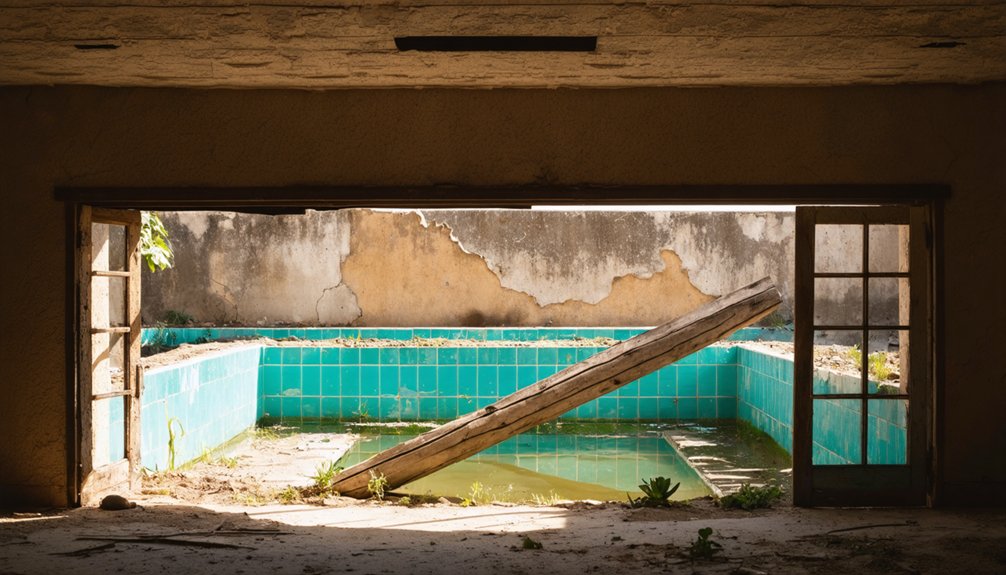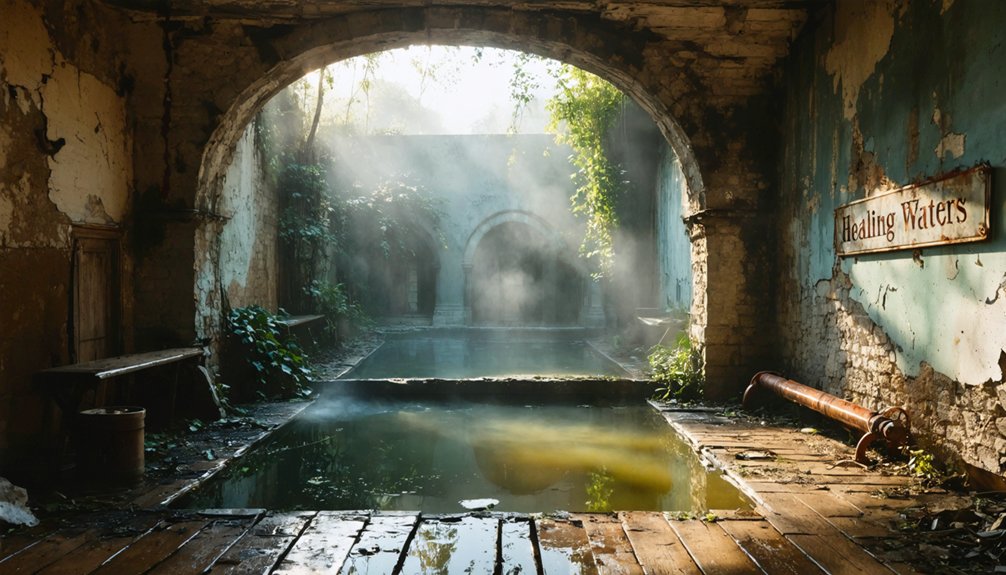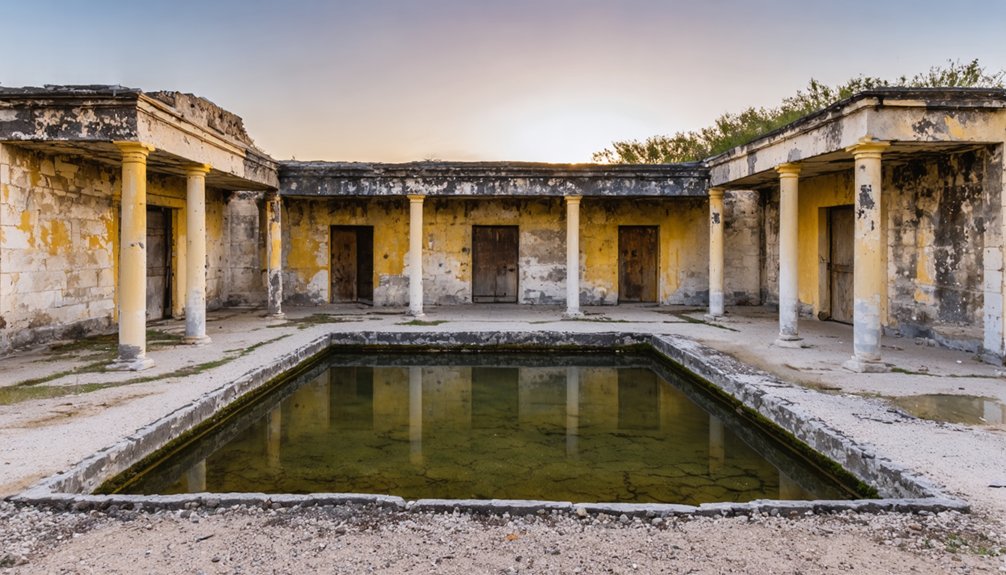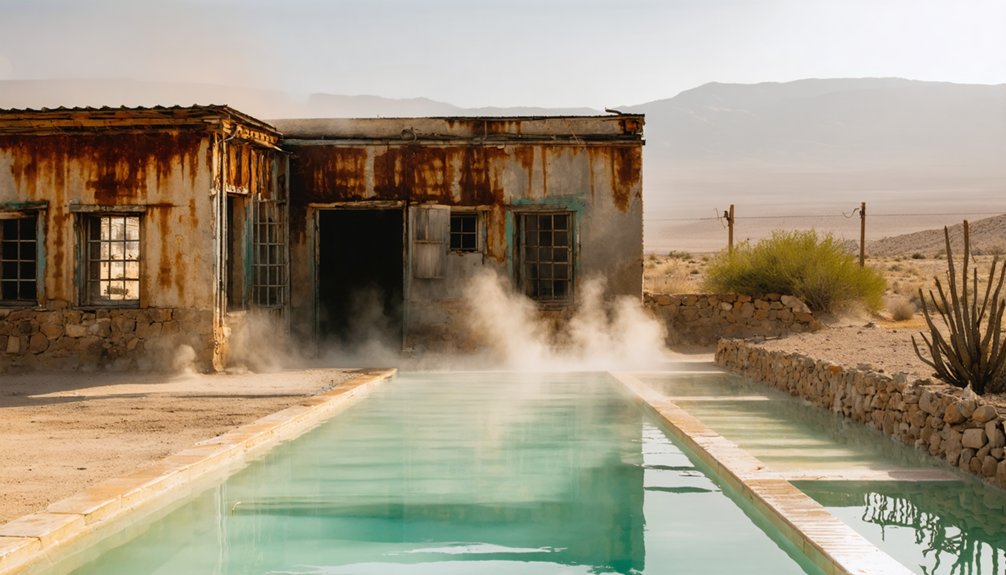You’ll discover Hot Springs ghost town nestled within Big Bend National Park, where J.O. Langford built a thriving health resort in 1909. Native Americans originally considered these thermal waters sacred, and the site later became famous for its therapeutic limestone springs reaching up to 147°F. Today, you can explore the remnants of Langford’s bathhouse, post office, and trading post while walking the same grounds where notable visitors like Teddy Roosevelt once sought healing waters.
Key Takeaways
- Hot Springs, Texas transformed from a thriving health tourism destination to a ghost town after J.O. Langford sold the property in 1942.
- The abandoned limestone bathhouse ruins and homestead buildings remain as testament to the once-bustling desert spa community.
- The ghost town sits within Big Bend National Park, featuring historic structures including Langford’s original 1909 bathhouse and trading post.
- Natural thermal springs that once drew thousands of health-seeking visitors still flow, though bathing is no longer permitted.
- Archaeological remains, including Native American petroglyphs and pioneer structures, preserve the ghost town’s cultural significance.
The Sacred Waters That Started It All
While most Texas springs merely trickle, the Hot Springs’ powerful flow of 250,000 gallons per day made it a geological marvel in 1936.
You’ll find these sacred springs maintaining a constant temperature of 105°F, heated by Earth’s geothermal forces and enriched with healing waters containing calcium carbonate, sodium sulfate, and rare lithium.
Long before settlers arrived, the Jornada Mogollon people recognized the springs’ spiritual significance.
The ancient Jornada Mogollon recognized these waters as sacred ground, understanding their power long before European footsteps touched this land.
The healing waters drew diverse groups to this natural pharmacy, where Native Americans performed sacred rituals and sought cures.
The springs’ unique mineral composition, characteristic of Texas geothermal features, made them a crossroads of cultures.
Both indigenous peoples and settlers from both sides of the Mexico-Texas border would gather here, drawn by the promise of the waters’ therapeutic properties.
The site’s significance is evidenced by ancient pictographs on cliffs that tell stories of the tribes who once called this sacred place home.
In the late 1920s, developers transformed the area into a health resort complete with a rock hotel and bathhouse.
J.O. Langford’s Vision and Pioneering Spirit
After contracting malaria as a child in Mississippi, J.O. Langford sought healing in the mineral-rich waters of West Texas. His vision transformed a remote desert spring into a thriving community hub that embodied the spirit of frontier innovation and resilience. His determination paid off when he received full healing after soaking for 21 days.
The springs maintained a constant temperature of 105°F, providing reliable therapeutic benefits to visitors year-round.
Langford’s Innovations shaped the region through:
- Building the first modern bathhouse with skilled German stonemason Herman Jacobs
- Establishing essential services like a post office serving both sides of the border
- Creating a motor court to accommodate the rising tide of automobile travelers
- Fostering cross-cultural cooperation by sharing land with the Natividad family
The Community Resilience you’ll find in Langford’s story shows in his determination to rebuild after the Mexican Revolution forced evacuation.
His adaptation to changing times continued until selling to Texas in 1942.
Native American Heritage at the Springs
You’ll find that Native Americans considered these hot springs a sacred place of healing, using the mineral-rich waters for physical and spiritual rejuvenation over thousands of years.
Native Americans called this area the “valley of the vapors” due to the mystical appearance of steam rising from the springs. The springs served as neutral territory where multiple tribes, including the Apache, Tunica, Caddo, Quapaw, Choctaw, and Cherokee, could gather peacefully despite ongoing conflicts elsewhere.
The site’s petroglyphs and pictographs, carved and painted on nearby limestone cliffs, stand as enduring proof of the deep cultural significance these waters held for indigenous peoples. A carved stone trough at Chief Spring provides evidence of ancient inhabitants’ interactions with these sacred waters.
Sacred Healing Traditions Continue
Before European settlers arrived in Texas, indigenous peoples maintained deep spiritual connections to the region’s hot springs, integrating these sacred waters into their holistic healing practices.
Like the Southern Ute tribe who called them “healing waters”, these natural springs were powerful centers of spiritual practices where healers combined physical treatments with ceremonial rituals.
The cultural significance of these springs went far beyond simple relaxation – they were powerful centers of spiritual practices where healers combined physical treatments with ceremonial rituals. The success of these treatments often depended on healing traditions passed down through generations of curanderos and indigenous healers.
- Shamans and curanderas used mineral-rich waters alongside plant medicines for treating chronic pain, skin conditions, and digestive issues.
- Daily immersion and drinking rituals were believed to activate the body’s natural healing abilities.
- Sacred ceremonies included prayers, fire rituals, and dances to invoke the waters’ healing powers.
- Archaeological evidence, like carved rock bathtubs, shows the springs’ long-term importance in Native American healing traditions.
Apache Peace Gathering Place
The sacred hot springs of Texas served as a remarkable neutral gathering place where even fierce Apache warriors laid down their weapons to participate in healing rituals and peace negotiations.
The Warm Springs Apaches, including leaders like Chief Victorio and Geronimo, frequented these waters for both physical and spiritual restoration.
You’ll find echoes of Apache diplomacy in the oral histories that describe these springs as hallowed ground where opposing tribes ceased hostilities. During the mid-1700s, Apache chiefs demonstrated their commitment to peace by burying war instruments at these sacred sites.
The tradition continues through events like the Geronimo Days Peace Gathering, established in the 1990s with the blessing of Geronimo’s descendants.
Harlyn Geronimo shared important family history during peace gatherings at these sacred grounds.
When you visit, you’re standing where generations of Apache peoples conducted sacred ceremonies, forged peace treaties, and found respite from the conflicts that shaped the American Southwest.
Building a Desert Oasis: Early Development
After purchasing the Hot Springs land in 1909, J.O. Langford transformed an untamed desert flora landscape into a thriving desert oasis.
Despite regional instability and harsh conditions, his economic resilience led to establishing essential infrastructure that would serve both locals and visitors.
Key developments included:
- A stone bathhouse with cemented rock tubs offering therapeutic springs access
- A limestone-block trading post and post office serving as a regional hub
- Canvas-roofed bathing shelters built near secondary springs
- Motor court facilities added in 1927 for automobile travelers
You’ll find Langford’s pioneering spirit reflected in every careful construction choice, from the initial adobe house overlooking the springs to the strategic placement of visitor facilities.
Even when border unrest forced temporary abandonment in 1912, his vision for a desert wellness destination never wavered.
Life and Commerce in the Borderlands

Situated strategically along the San Vicente-Boquillas wagon road, Hot Springs emerged as a vibrant borderlands trading hub where Anglo settlers and Mexican families forged cooperative commercial relationships.
You’d find J.O. Langford’s store and post office at the heart of border trade, where weekly mail deliveries drew the community together. Life centered around stone cabins with shared porches, while residents sustained themselves through farming, commerce, and health tourism.
The bathhouses became focal points of cultural exchange, charging twenty-five cents per bath or five dollars for twenty-one sessions.
You could witness diverse economic arrangements, from tenant farming to store work, as families like the Natividads participated in the cross-border economy, creating a unique blend of Anglo and Mexican traditions in this desert community.
Tales From the Limestone Bathhouse
Rising from limestone blocks in 1909, J.O. Langford’s bathhouse transformed the rugged Texas borderlands into a healing sanctuary. The limestone architecture, crafted by stonemason Herman Jacobs, featured cement-plastered rock tubs where you’d find visitors seeking natural cures.
At just 25 cents per bath, you could experience these healing rituals that blended Native American traditions with frontier medicine. The bathhouse’s significance extended beyond its therapeutic waters:
- Served as a crucial community hub and trading post
- Connected San Vicente to Boquillas via the wagon road
- Featured hand-painted murals and flagstone terraces
- Attracted health tourists from both sides of the border
Though floods destroyed the main structure in 1938, you can still explore the foundational ruins along the Rio Grande’s north bank, where the bathhouse once stood as a symbol of borderland ingenuity.
The Golden Era of Health Tourism

You’d have found Hot Springs bustling with health-seekers during its prime, as thousands flocked to experience the therapeutic limestone waters that doctors widely endorsed for everything from backaches to diabetes.
The bathhouse’s mineral-rich springs drew visitors from across America, including celebrities like Teddy Roosevelt and Clark Gable, who’d stay for weeks seeking relief through daily soaks and mineral water drinks.
Native American healing traditions merged with European spa practices at Hot Springs, where accessible 25-cent baths made the curative waters available to visitors of all backgrounds.
Medicinal Waters Draw Visitors
During the late 19th and early 20th centuries, Texas’s mineral springs became a magnet for health-seeking visitors, with destinations like Hot Springs drawing thousands annually.
You’d find yourself among notable figures like Teddy Roosevelt and Clark Gable, all seeking the healing properties of these natural wonders. At Hot Springs, you could experience the 105°F waters rich in minerals like calcium carbonate and lithium, with locals claiming cures for various ailments.
- Thermal baths cost just twenty-five cents, making healing accessible to all
- Waters treated everything from rheumatism to skin diseases
- J.O. Langford recovered from malaria using these springs
- Visitor experiences included both drinking and bathing in mineral waters
Whether through bathing or drinking, these medicinal waters drew people from across the nation, each seeking their own path to wellness in Texas’s natural springs.
Historic Bathhouse Health Benefits
The golden era of health tourism brought sophisticated bathhouse facilities that transformed Hot Springs into a premier wellness destination.
You’d find an array of therapeutic treatments, from needle baths to Turkish-style radiant rooms, all designed to harness the healing properties of the natural springs. The bathhouse architecture incorporated both social spaces and private treatment areas, with waters heated to 105-147°F for maximum therapeutic benefit.
If you visited during this period, you’d undergo an extensive three-week regimen combining daily mineral water treatments, massages, and electrical therapy.
The sulfurous waters were particularly valued for treating rheumatism, skin conditions, and joint diseases. While some medical professionals remained skeptical, many doctors endorsed these treatments based on their clinical observations of patient improvement.
Cross-Cultural Healing Traditions
While mainstream medicine dominated healthcare in the late 19th century, Hot Springs’ health tourism created a unique convergence of healing traditions.
You’d find diverse cultural exchanges happening around the mineral springs, where formally trained doctors worked alongside alternative practitioners. The region’s healing rituals blended scientific theories with traditional folk remedies, attracting visitors seeking freedom from conventional treatments.
- Natural thermal waters reaching up to 147°F provided therapeutic soaking treatments
- Mineral-rich springs containing sulfur, calcium, and sodium targeted specific ailments
- Local geological features created unique water properties for various healing methods
- Combined internal and external treatments reflected holistic healing approaches
This integration of different healing traditions made Hot Springs a melting pot of cross-cultural medical knowledge, where you could explore both time-tested remedies and emerging therapeutic practices.
From Bustling Resort to Silent Ruins

At its peak in the 1920s, Hot Springs, Texas flourished as a sought-after health destination, with J.O. Langford’s resort offering affordable therapeutic baths at 25 cents each.
You could’ve found relief from various ailments including malaria, rheumatism, and kidney diseases while staying in stone cabins adorned with murals or relaxing in the limestone bathhouse.
Archaeological Treasures and Rock Art
Hidden beneath layers of history, Hot Springs’ archaeological treasures tell a rich story of human settlement spanning centuries.
You’ll find evidence of the Jornada Mogollon people who left their mark on limestone cliffs through intricate rock art and petroglyphs. The area’s archaeological significance extends beyond indigenous artifacts to include structural remains that paint a picture of early American frontier life.
- Ancient pictographs reveal spiritual and cultural practices of early inhabitants
- Ruins of Terlingua Abajo, complete with cemetery, showcase settlement patterns
- River Road East features three distinct structural ruins near Tornillo Creek
- Rock hotel and bathhouse remains document the area’s resort-town evolution
Today, these irreplaceable treasures face threats from modern development, making their preservation essential for understanding the Big Bend region’s rich cultural heritage.
Preserving a Piece of Texas History
You’ll find Hot Springs’ archaeological sites receive dedicated protection through its National Register of Historic Places designation, which helps secure funding and legislative safeguards for these irreplaceable cultural resources.
The site’s preservation efforts extend beyond physical protection to include robust community education programs that teach visitors about the region’s rich Native American heritage and early resort history.
Your visit to this carefully preserved ghost town connects you with both ancient rock art and early 20th-century health resort culture, showcasing Texas’ commitment to protecting its diverse historical treasures.
Archaeological Sites Protection
Preserving the archaeological treasures of Hot Springs, Texas requires a complex network of legal protections and conservation efforts. The site’s archaeological significance is protected under the National Historic Preservation Act and Texas Antiquities Code, with specific oversight from State Historic Preservation Officers for any development near these cultural landmarks.
Key aspects of site management include:
- Regular monitoring and documentation through university-led archaeological fieldwork
- Environmental and cultural impact assessments for nearby infrastructure projects
- Enforcement of penalties against unauthorized excavation or artifact removal
- Integration with cultural tourism initiatives to promote public education
You’ll find these measures vital in protecting sites like Indian Hot Springs, which earned a spot on the National Register of Historic Places and remains an essential piece of Texas’s cultural heritage.
Cultural Heritage Awareness
While many ghost towns fade into obscurity, Hot Springs stands as a powerful symbol of Texas’s rich cultural tapestry, earning its place on the National Register of Historic Places in 1990.
You’ll find a remarkable blend of indigenous history, settler impact, and early health tourism preserved within its boundaries.
Understanding the site’s cultural significance has become vital in protecting it from modern threats like the proposed Saguaro Connector Pipeline. Your awareness of this heritage helps guarantee funding for preservation efforts and maintains public support for protecting historic structures.
When you visit, you’ll experience tangible connections to the past through the bathhouse ruins, homestead buildings, and mineral springs. This cultural heritage preservation guarantees future generations can explore Texas’s diverse history in this unique desert landscape.
Community Education Programs
Thorough community education programs form the backbone of Hot Springs’ historical preservation efforts. Through community workshops and educational grants, you’ll discover the rich heritage of this Texas ghost town while learning preservation techniques and environmental stewardship.
- Experience hands-on preservation training to maintain historic structures and artifacts
- Participate in guided field trips featuring augmented reality technology
- Join interactive sessions combining Texas history with ecological education
- Engage in cultural demonstrations led by local historians and original residents’ descendants
You’ll find diverse learning opportunities through partnerships with Texas Parks and Wildlife Department, local museums, and historical societies.
Whether you’re exploring through volunteer-led tours, documenting oral histories, or participating in outdoor activities, these programs connect you directly with Hot Springs’ fascinating past while ensuring its preservation for future generations.
Frequently Asked Questions
What Was the Average Year-Round Temperature of the Hot Springs?
You’ll find average climate readings hovered around the lower to mid-70s°F year-round, with temperature variations ranging from winter lows near 40-50°F to summer highs around 90°F.
How Many People Lived in Hot Springs During Its Peak Population?
Like many small Texas spring settlements, you’ll find that historical records don’t specify the exact peak population, but evidence suggests it probably didn’t exceed a few hundred residents during its period of growth.
Were There Any Notable Deaths or Accidents at the Hot Springs?
You won’t find documented tragic accidents or mysterious disappearances at these springs – historical records, including Langford’s accounts and National Park Service documents, show no notable deaths or safety incidents there.
Did Bandits or Outlaws Ever Target the Hot Springs Settlement?
Where there’s smoke, there’s fire, but you won’t find concrete evidence of bandit raids or outlaw hideouts targeting Hot Springs, despite local fears and its strategic border location in early 1900s Texas.
What Happened to J.O. Langford’s Descendants After the Town’s Decline?
You’ll find limited records of the Langford legacy after 1942. While some relatives moved to El Paso, and others to Mexico by 2003, the family fortunes dispersed following J.O.’s death in 1961.
References
- https://www.nps.gov/bibe/learn/historyculture/hotsprings.htm
- https://riverbendhotsprings.com/history-of-riverbend-hot-springs/
- https://www.dallasites101.com/blog/post/terlingua-texas-ghost-town-guide/
- https://www.tshaonline.org/handbook/entries/hot-springs-tx
- https://www.bexar.org/3057/Hot-Wells-of-Bexar-County
- https://visitbigbend.com/j-o-langfords-hot-springs-brief-history/
- https://npshistory.com/publications/bibe/nr-hot-springs.pdf
- https://en.wikipedia.org/wiki/List_of_ghost_towns_in_Texas
- https://www.texasescapes.com/FEATURES/Indian_Hot_Springs_Texas/Indian_Hot_Springs_Hudspeth_County.htm
- https://www.preservationtexas.org/mep/indian-hot-springs



